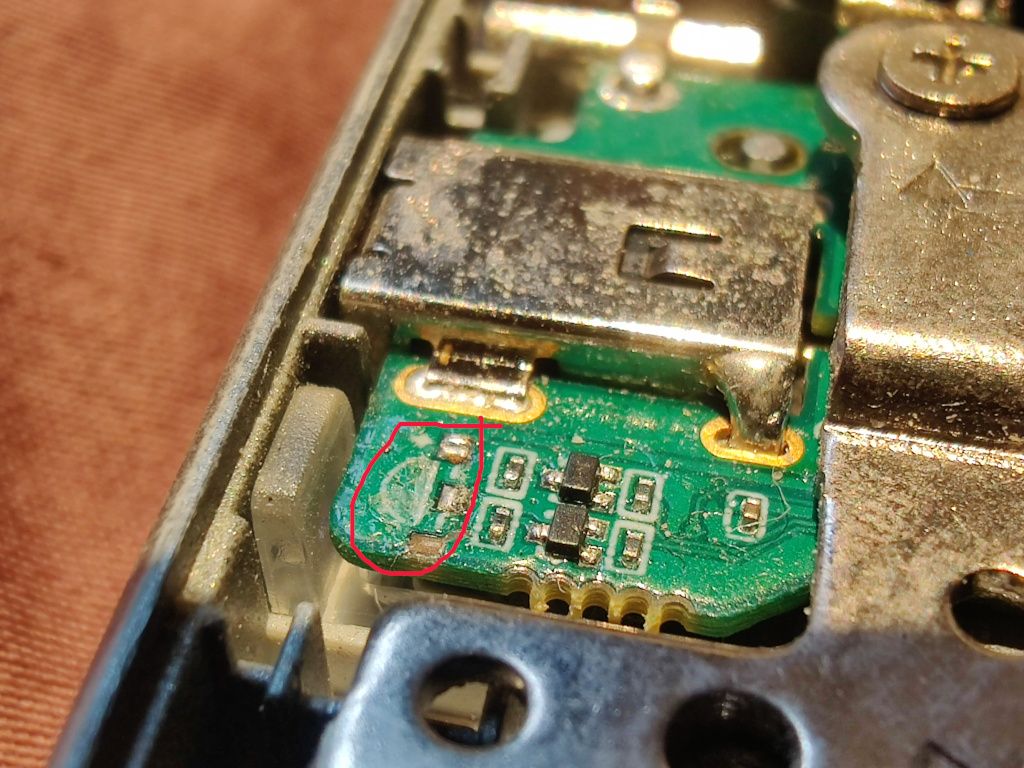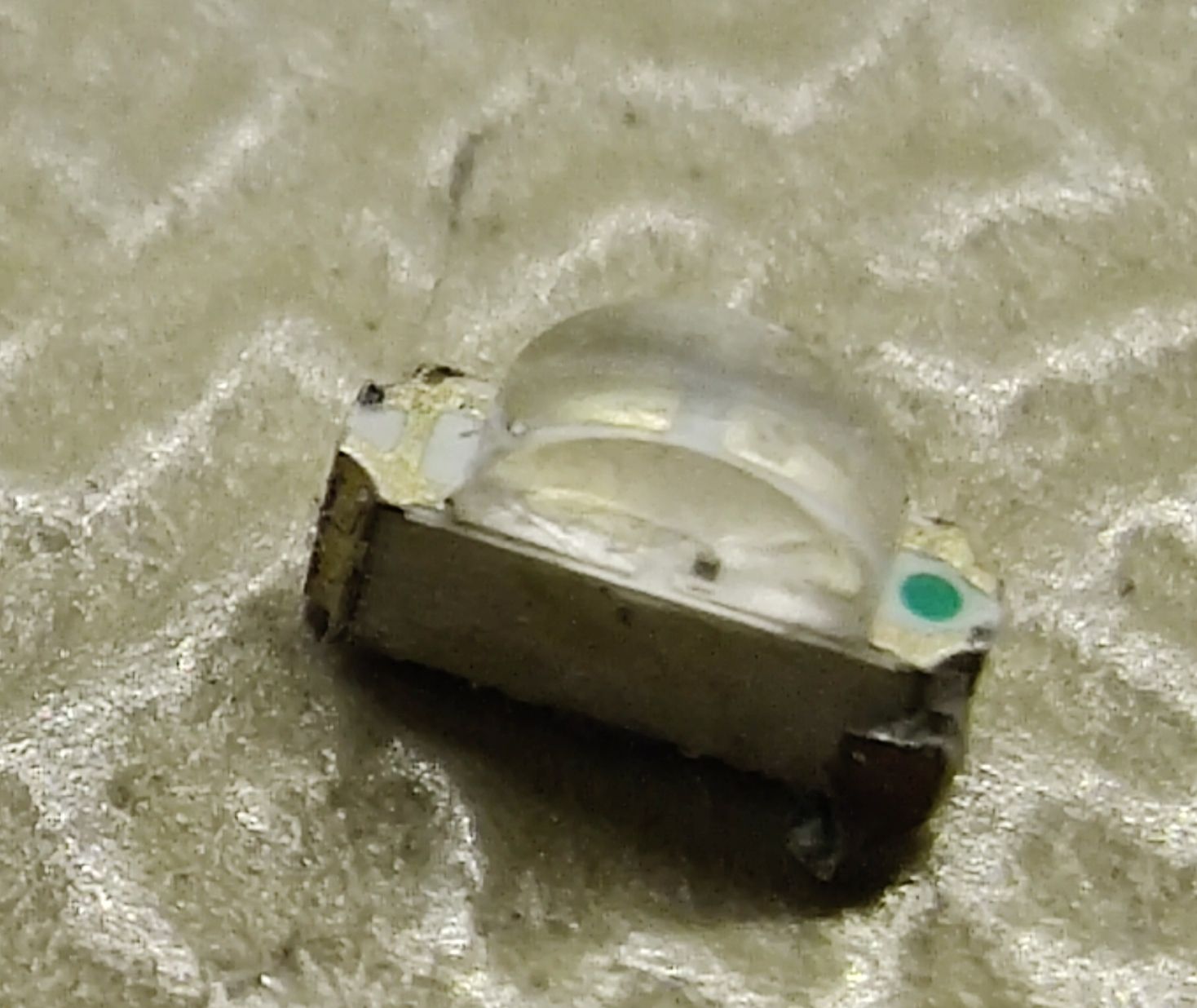I noticed a tiny component near the power input connector was loose. Looks like a LED? Could it have dis-soldered due to some sort of overheat?



I noticed a tiny component near the power input connector was loose. Looks like a LED? Could it have dis-soldered due to some sort of overheat?



My CM5 laptop power input suddenly stopped working. The power adapter is working, I tried another adapter, didn't help. The laptop still booted and worked normally until the battery became exhausted.
What could have happened? Is there some sort of fuse on the board?
Is there component layout and/or schematic for the laptop carrier board public available? Thanks.
@george Yes I was considering the possibility to base a custom board on a CM5 module, for a project.
I tried to google for a CM5 module reseller but couldn't find one. Where can I buy it? Thanks.
@george Thanks that solved my problem.
I followed the kernel update instructions (git clone, compile, copy, reboot) and now I have no network interfaces and no bluetooth. I don't have time to dig into it right now, just wanted to warn that something may be missing in the instruction.
@enok71 Just in case someone reads my postings in this thread: The best source for coolpi hardware support packages is probably Georges ppa. Probably best to avoid mixed in packages from Liu Jianfengs ppa.
@jack_admin I believe there can be different variants with different price tags. The top model could be e.g. at least double your current price. If the features appeal to technology aware consumers in west I think they have no problem paying for it.
Imagine a 1440p camera showing showing crystal clear streaming video in "Teams", with the hardware accelerated video drivers doing their job so that the fan remains quiet. That would be a laptop to pay for. Colleagues would ask "what laptop is that??". It would advertise itself.
A high quality keyboard is also a very important fundamental requirement for buyers with budget. I personally think backlight should be mandatory. And international keyboard laptops are impossible to sell in Scandinavia.
The security related features I mentioned (fingerprint reader, security chip, NFC reader) are more "nice to have" things, but would give the laptop a security edge, and everyone ask for (and will pay for) improved IT security these days. Make sure "secure boot" is implemented and working if going that path. Linux and open source software is preferred before Windows for security aware users and you already have that.
These are my thoughts. Of course I know very little about e.g. Chinese customer needs or wishes.
@anernest I also apreciate this laptop, although I have no need at all for touch screen, 5G modem or tablet mode. Would be more interested in
Answering myself once more ... there is a ppa here although I'm not sure that's the optimal one for rk3588?
If someone is more sure of the best place to look for hardware accelerated software packages please help.
Ok the following command line actually seems to work with my own compiled ffmpeg-rockchip, based on my own compiled rkrga and rkmmp. And top shows zero cpu-load so the CPU is actually not used at all.
ffmpeg -i /dev/video0 -c h264_rkmpp /tmp/tmp.mp4
Still interersted in URL to some source of precompiled Ubuntu packages though. Thanks.
I'm trying to explore hardware acceleration features on my rk3588 based laptop. I run Ubuntu 22.04 as installed when I received it.
Are there any package sources (ppas?) that I could add to make this work easily? Or do I have to recompile all the libraries myself from github repositories?
I found ffmpeg-rockchip and compiled rkrga, rkmpp and ffmpeg-rockchip yesterday trying to get an ffmpeg that uses r3588 hardware video encoder. But it fails to run. Do I need to recompile libdrm also? The kernel?
Thank you and best regards!
/usr/local/bin/ffmpeg -f video4linux2 -i /dev/video0 -f hevc ../tst.h264
ffmpeg version 50cc62684a Copyright (c) 2000-2023 the FFmpeg developers
built with gcc 11 (Ubuntu 11.4.0-1ubuntu1~22.04)
configuration: --prefix=/usr/local --enable-gpl --enable-version3 --enable-libdrm --enable-rkmpp --enable-rkrga
libavutil 58. 29.100 / 58. 29.100
libavcodec 60. 31.102 / 60. 31.102
libavformat 60. 16.100 / 60. 16.100
libavdevice 60. 3.100 / 60. 3.100
libavfilter 9. 12.100 / 9. 12.100
libswscale 7. 5.100 / 7. 5.100
libswresample 4. 12.100 / 4. 12.100
libpostproc 57. 3.100 / 57. 3.100
Input #0, video4linux2,v4l2, from '/dev/video0':
Duration: N/A, start: 14443.933156, bitrate: 147456 kb/s
Stream #0:0: Video: rawvideo (YUY2 / 0x32595559), yuyv422, 1280x720, 147456 kb/s, 10 fps, 10 tbr, 1000k tbn
Stream mapping:
Stream #0:0 -> #0:0 (rawvideo (native) -> hevc (hevc_v4l2m2m))
Press [q] to stop, [?] for help
[hevc_v4l2m2m @ 0x5566a0db90] Could not find a valid device
[hevc_v4l2m2m @ 0x5566a0db90] can't configure encoder
[vost#0:0/hevc_v4l2m2m @ 0x5566a0d810] Error while opening encoder - maybe incorrect parameters such as bit_rate, rate, width or height.
Error while filtering: Operation not permitted
[out#0/hevc @ 0x5566a0c690] Nothing was written into output file, because at least one of its streams received no packets.
frame= 0 fps=0.0 q=0.0 Lsize= 0kB time=N/A bitrate=N/A speed=N/A
Conversion failed!
@george One strong reason for considering this is that EU requires, or will require, all laptops sold new here to support powering from USB-C. (It is an effort to reduce the number of incompatible power connectors and associated waste and headache for consumers).
@george Did you have any success with this? It would be really nice to see Armbian 23.11 with mainline kernel running on the CM5 laptop!